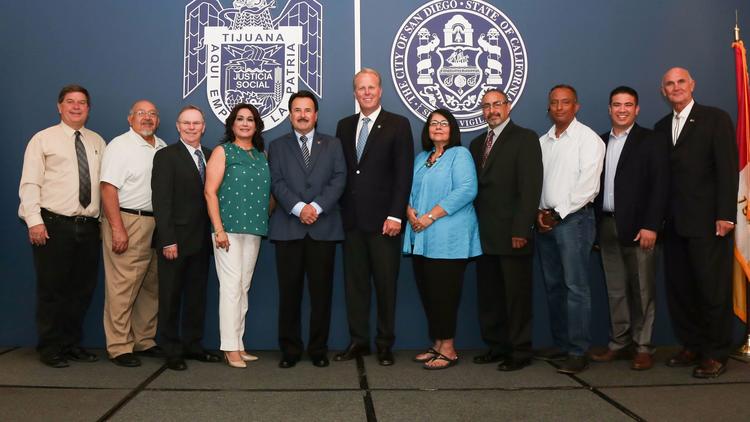At a sensitive moment in U.S.-Mexico relationship, San Diego and Tijuana hosted a binational gathering of mayors last week.
The U.S.-Mexico Border Mayors Association brought together leaders of about 20 border communities for two days of meetings that touched on subjects such as trade, the environment, health, and border infrastructure. Four of the mayors came from Mexico, the remainder from the United States.
In separate interviews, a half-dozen U.S. border mayors participating in the conference spoke of their common concerns. A desire to improve the North American Free Trade Agreement. The need to upgrade ports of entry. And frustration over President Donald Trump’s plans for a fortified border wall.
James Darling, McAllen, Texas, population 150,000. Across from Reynosa, Mexico, the city in 2014 became ground zero for the surge of Central American immigrants.
Mayor Darling said that McAllen, a center for ecotourism, already has a natural boundary with Mexico — the Rio Grande — and said building the wall “is going to separate some of our natural sites.”
“This week, they’re drilling sample holes for a new wall,” said Darling. “I don’t particularly like the wall…It’s not fair to the property owners of the city.”
“I think the Border Patrol does a good job. I would listen to them rather than listen to politicians.”
As for NAFTA, “it’s very important to us,” Darling said. “We have a very active trade zone in our city, and we realize the benefits. We want to tweak it and make it better.”
Andres Ramos, Alpine, Texas, population 6,000. Located in the Big Bend region, a sparsely populated area about 80 miles from the Mexican border and the city of Ojinaga.
“We’d like to see more trade with Mexico,” Mayor Ramos said. “We need to have a steady, aggressive income.” He sees potential in importing produce from Mennonite farms in northern Chihuahua.
As for the border wall, Ramos said the funds could be better spent on local law enforcement agencies. “I don’t care for the border wall, and neither does our county sheriff.”
The Rio Grande is a natural barrier with Mexico: “We have some high cliffs and canyons which make it impossible to cut a wall there,”: Ramos said. “Leave it alone, just give us better equipment for our police force.”
Javier Perea, Sunland Park, New Mexico, population 16,000. The community borders El Paso, Texas and Chihuahua, Mexico.
“The symbolism (of a wall) is just terrible,” Perea said. “Where we live there’s not a lot of cross-border immigration. It’s desert, it’s mountainous, sparsely populated. it’s easy to cross the border, but there’s nowhere to go.
“Instead of investing money in a wall, they should invest money on technology and improve border security through technology,” said Perea.
Gerardo Sanchez, San Luis, Ariz., population 35,000. Located near Yuma and San Luis Rio Colorado, Sonora.
“My biggest concern is infrastructure, economic development,” Sanchez said. “I think we need to unify, we need to use raw numbers, we need information, we need figures,” to make a strong case to federal agencies.
Sanchez wants to upgrade the seven-lane port of entry, built in the 1980s. There is already a wall, and reinforcing it would not make his community safer, he said.
“Do we want to isolate ourselves? No we don’t. We have neighbors, we have families, we have business partners…this wall is creating more animosity against Mexico and I think more fear in the United States.”
Jose Yepez, mayor of Somerton, Ariz., population 17,000. Located west of Yuma.
Expansion of the port of entry is a major concern for his city, which is part of an agricultural region that relies on labor from south of the border.

Mayors representing border communities in Texas, New Mexico, Arizona and California pose at last week’s gathering, which took place in Tijuana and San Diego. (City of San Diego)
“We have workers that live in Mexico, and they cross over to harvest our lettuce and stuff like that,” he said. “They get up at two or three o’clock in the morning, for a two- or three-hour long wait in line, and then an hour to go to the fields, and work the whole day.”
The border wall, “that’s not going to do anything,” he said. “They can build it as high as they want to, supply and demand, simple economics.”
Maritza Hurtado, mayor of Calexico, Calif., population 40,000. Across from Mexicali, Baja California.
Born in Calexico, Hurtado is a U.S. citizen who also holds Mexican citizenship.
She said her city has a “big problem” as the president’s 2018 budget left out funding for the second phase of the Calexico West Port of Entry — a project that would add a pedestrian processing facility as well as six additional northbound vehicle inspection lanes.
She is “totally against,” plans for a border wall. “It divides us, there is no need, we are one community divided by a wall.”
By Sandra Dibble for San Diego Union Tribune
Source: San Diego Union Tribune

